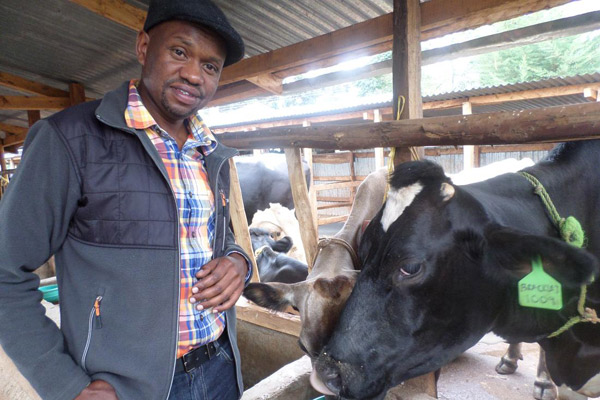Goshobu Dairy Farm is a two-acre farm owned by Dr Dan Koros.
It hosts a 160 by 44ft dairy unit, feeds stores, various kinds of fodder, 29 Friesian cows and his home.
The dairy unit is partitioned into four sections for high and low producing cows, dry cows and section for calves and heifers. And each cow has sleeping mat.
From the 12 cows he milks, Dr Koros gets an average of 200 litres with the high producer offering 30 litres while the lowest 15 litres per day which he sells at Sh50 a litre.
Koros runs the farm using an app called Smart Cow Dairy. “Everything on this farm is here,” say Koros, pointing at his mobile phone. “The app helps me control the entire business from breeding to feeding to selling. With the system, I am able to manage and track records of the 29 dairy cows, 12 which I milk, two in-calf and the rest heifers.”
To track the milk sales, he has in the app records of all the hotels, tea estates and milk coolers that he supplies milk to, thus, at the end of the month, it is easier to know his earnings.
“With the data, I normally print out and send invoices to the clients easily,” says the father of four.
The system further automatically calculates total milk production from the cows, highlighting the highest and lowest producers.
“With the system, we do our calculations, a kilo of dairy meal translates to about three litres of milk. For example, if a cow is producing 30 litres, we give about 8kg of dairy meal per day while the one producing 15 litres we give it 3kg of dairy meal,” says Koros, adding that he buys commercial dairy meal and mixes with maize, maize bran and cotton seeds cake.
He also grows lucerne (alfalfa) and purple vetch, which are sources of protein while yellow maize, napier grass and oats, which he also farms, offer carbohydrates.
His secret to raising healthy animals is in good management of in-calf cows and calves as well.
Nicholas Kirimi: I make Sh. 20,000 from dairy farming but I’m working to earn more
“Timing is crucial in serving the heifers or the dairy cows. The app automatically creates a breeding calendar once you enter all the records of served cows. It does the automatic calculation of the first heat check, second, pregnancy diagnosis date and due date,” explains Koros, who started the farm in 2009 after buying three heifers at Sh. 40,000 each and added two more heifers in 2010, which he acquired at Sh140,000 each.
Once a cow shows signs of being on heat, he leaves it for 18 to 24 hours before it is served.
“You need to study your cows because each has different fertility. Some are easy to conceive while others are difficult even if they are on heat,” says the 40-year-old farmer.
The software further alerts the farmer about the drying and steaming dates.
“Last year I had six straight calvings between July and December, thanks to the app. At the end of the year, I always make an analysis of the calving system to know where I need to improve.”
Further, monitoring of the animals’ health has never been easier for Koros as the software keeps records of treatment, including diagnosis and medication.









Kindly advice me on how to get the smart cow software
Kindly how can I get a fresian cow
Hi Koros,
Kindly advice on how i can acquire the smart cow software. If you have some advice on a novice farmer, please help